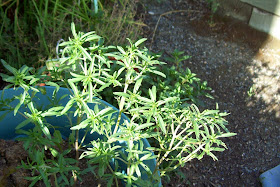 |
| Photo Joyce D'Agostino |
If you enjoy growing culinary herbs, you might want to consider adding Summer Savory (Satureia hortensis) to your herb garden.
I have heard of this herb for a number of years and wanted to finally give it a try. This spring I started the seedlings inside and simply transferred the tiny plants to a pot outside once the plants developed their second leaves. I moved it to the full sun next to my other herbs and it quickly began to grow in height.
This herb is a native of Southern Europe and some reports say that next to salt and pepper, this herb is the most frequently used in the kitchen and on the table. Those who love to make dishes such as beans or stuffed cabbage report that this herb adds a subtle aromatic flavor to these dishes. Since Savory has a mild peppery flavor, it can also be added to salad dressing and to marinades for meats as a substitute for black pepper.
The plants are considered annuals and can grow from 12 -18” tall so make a nice border plant. I found their leaves very attractive and it has been easy to grown and maintain. It has light purple flowers later in the season and then the leaves can turn a nice reddish bronze color after frost. Once they have flowered, pull up the entire plant and hang them to dry and use the crumbled dried leaves in dishes for fall and winter cooking.




